Hard disks are fundamental components for storing data and have been used since the 1950s. Since their beginnings, they have undergone various evolutions and improvements, becoming increasingly compact, reliable and capable of storing large amounts of data.
In this article, we’ll explore the history of the hard disk and its main developments over time, from the early days of magnetic disks to today’s high-tech hard disks and storage capacity. We’ll see how these devices were developed, how they have evolved and how they have affected the technology we use today.
What is a hard disk?
A hard disk is a data storage device that uses one or more metal plates coated with a layer of magnetic material, where information is written and read via read/write heads that move over the surfaces of the disks.
Hard disks are the main data storage devices used in personal computers, as well as in servers, external storage devices and cloud storage devices. They are responsible for storing various types of data, such as operating systems, programs, files, music, photos and videos.
The hard disk is connected to the computer via an interface, usually SATA (Serial Advanced Technology Attachment) or SAS (Serial Attached SCSI), and is powered by a power supply. The storage capacity of hard disks ranges from a few GB to several TB, and their read and write speeds also vary depending on the model.
As technology advances, the storage capacities and speeds of hard disks are increasing, making them ever more reliable and capable of storing large amounts of data.
Who invented the hard disk?
The invention of the hard disk is considered an important milestone in the history of data storage technology. The first hard disk was created by Reynold Johnson, an electrical engineer working for IBM in the early 1950s. His invention, called RAMAC (Random Access Method of Accounting and Control), was presented in 1956 and consisted of five magnetic disks that stored a total of five million characters, equivalent to around 4.4 MB of data.
It was the first magnetic disk-based data storage device, and unlike previous storage devices, it could randomly access any point on the disk. Reynold Johnson’s invention of the disk was essential to the development of data storage technology and has been fundamental to the growth and evolution of technology in general.
Hard disk technology timeline
The hard disk has had a long way to go to become what it is today: its history begins in 1956 and has seen several milestones over the years. Discover each one below:
The first commercial hard disk
The IBM 350 was the first hard disk drive developed by IBM in 1956 and launched in 1957. It consisted of 50 magnetic disks with 50,000 sectors, each supporting 100 alphanumeric characters. In other words, its storage capacity was 5 Mb.
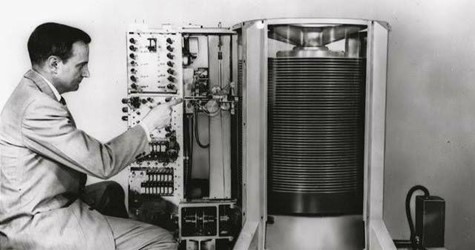
First hard disk with air bearing heads
In 1961, IBM launched the IBM 1301, which had heads designed to move on an air cushion in pneumatic bearings and read data from disks.
Compared to the IBM 350, the IBM 1301 was a major advance in storage, with a capacity of 19 Mb of data.
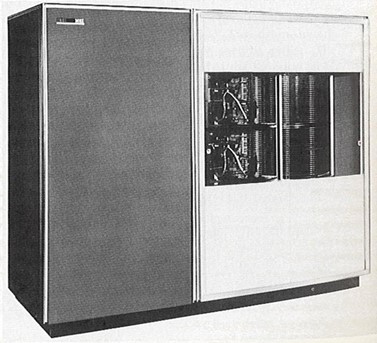
The removable disk package drive
The evolution of the IBM 1301 – the IBM 1311 – came in 1962, the first hard disk drive to feature removable disk packs. Each one contained around 2 million characters and twice the recording density of the previous version.
The size of the IBM 1311 was also a big improvement on previous versions. While the previous versions were about the size of a closet, this one was the size of a washing machine.
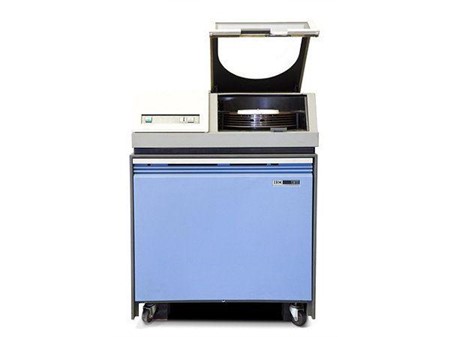
Eight-inch flexible discs
In the 1950s, companies were considering developing drives capable of storing larger volumes of data on a single device.
Then, at the end of the 1960s, IBM engineers in San Jose developed eight-inch hard disks – which didn’t go on sale until 1971.
These disks had an extremely limited storage capacity: around 80 Kb at most.
Microcomputers used for engineering, business, or word processing generally used one or more 8-inch floppy disk drives for removable storage.
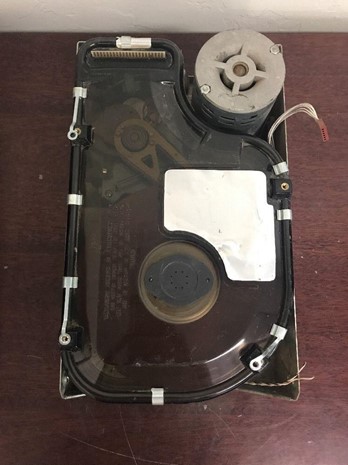
Sealed hard disk drive
In 1973, IBM created the Winchester 3340 hard disk: a sealed hard disk drive that had sealed hardware with lubricated mechanisms and a lightweight head.
The drive was distinguished by its smaller, lighter read/write head and its design, which made it possible to walk closer to the surface of the disk.
The Winchester was the first hard disk to function similarly to today’s hard disks and had twice the information density of IBM’s previous disks.
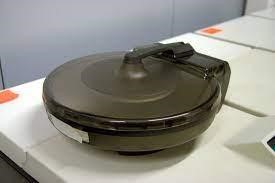
An evolution of eight-inch floppy disks launched in mid-1976, the floppy disk was a light, practical and portable drive, but with limited storage capacity (they only stored a maximum of 1.44 Mb). Because of this, several floppy disks were needed to store files.
A tecnologia RAID em disco rígido
RAID (Redundant Array of Independent Disks) disk technology was created in 1978 by IBM with the aim of improving the reliability and security of systems using the principle of redundancy.
Consisting of a set of two or more hard disks, RAID technology is mainly used in servers and fulfills two basic objectives:
- Increase the speed of the disk system using Data Division (RAID 0);
- Bring greater security to the disk system using the Mirroring technique (RAID 1).
Even with new data storage technologies, RAID technology is still widely used – thanks to its focus on security and speed.
Hard disk drives for microcomputers
In 1980, Seagate Technology (when it was still called Shugart Technology) launched the first hard disk for microcomputers, the ST506.
The drive featured an agile motor and disks that stored 5Mb each.
The ST506 was connected to the computer system via a disk controller and its interface between controller and drive was derived from Shugart Associates’ SA1000 interface (which, as far as it was concerned, was based on the floppy drive interface, making the design of the disk controller relatively easy).
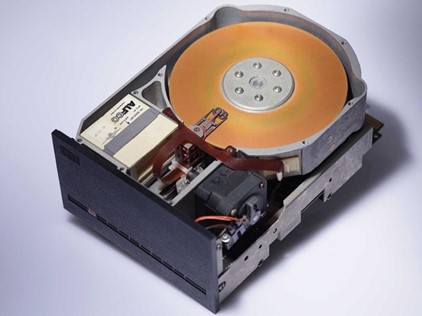
The introduction of IDE and SCSI
In the 1980s, the IDE (Integrated Drive Electronics) interface standards appeared, which were also called ATA (Advanced Technology Attachment) or PATA (Parallel Advanced Technology Attachment).
These standards innovated by bringing in the feature of operating with an integrated driver (controller).
IDE/ATA1 supported up to 540 Mb with a transmission rate of 8.3 Mb/s and a cycle time of 240 ns. Its eighth standard (ATA/ATAPI 8) had a transmission rate of more than 133 Mb/s, with storage capacity ranging from 40 Gb to 500 Gb.
At the end of the same decade, in 1986, the SCSI standard was developed for connecting hard disks and disks.
The standard had multi-tasking capability and high processing speed and was implemented in places that required higher transfer rates than those offered by IDE.
Looking at its timeline, the first SCSI had a maximum transfer rate of 5 Mb/s at a frequency of 5 Mhz, using 8 devices in a single connection.
The Ultra640 SCSI version, on the other hand, operated with a frequency of 160 Mhz and 16 connected devices, with a maximum transfer rate that even surpassed SATA-III, reaching 6440 Mb/s.
Introduction of Enhanced Integrated Drive Electronics
A term coined in 1994, EIDE (Enhanced Integrated Drive Electronics) is a set of extensions to the ATA-1 connection standard.
Also known as Fast ATA, Fast IDE or ATA-2, EIDE provided much faster transfer rates than IDE.
While the original IDE drive controllers supported a transfer rate of up to 8.3 Mb/s, EIDE supported up to 16.6 Mb/s (some of which could reach an average speed up to 4 times faster than IDE).
The EIDE standard could also support mass storage devices of up to 8.4 Gb, in contrast to the 528 Mb supported by IDE.
Introducing the SATA Interface
The SATA interface – a standard IDE for connecting devices such as optical drives and hard disks to computer motherboards – was introduced in 2000 to replace the old PATA ribbon cables.
SATA is basically an interface that allows storage devices to connect to host systems.
Various versions of this interface have been developed to allow for increased capacity and bandwidth.
The first 1 terabyte hard disk
In 2007, Hitachi Storage Technologies launched the world’s first 1 Tb hard disk: Deskstar 7k1000.
The device featured:
- Interface SATA or PATA;
- 200 RPM;
- Buffer de 32 Mb (SATA) or 8 Mb (PATA);
- Perpendicular recording technology;
- 5 platters and 10 recording heads;
- Anti-shock protection.
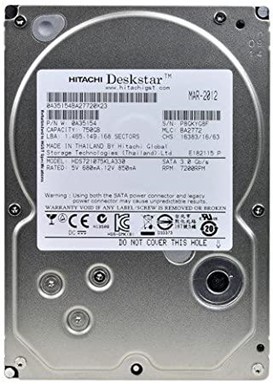
Conclusion
Over the years, the advances in hard disks have been remarkable – and the evolution is far from over.
With increasingly modern devices and more advanced features, the trend is for hard disks to undergo changes to keep up with this evolution.
But regardless of the technology used, the most important thing is to guarantee the security of your data storage, don’t you agree? Which isn’t always the case.
Whether it is due to device failure, exposure to falls or unsuitable physical conditions, you can end up losing the data saved on your hard disk.
After learning a little about the history of hard drives, have you realized that you need data recovery? Trust those with over a decade of experience in data recovery: Bot!
As well as offering free collection from any address in Portugal and sending your quote within 48 hours (or less), we work with Clean Room – guaranteeing that your hard disk will be safe from any kind of impurity.
If you need to recover your data, click on this link and become one of our more than 100,000 solved cases!


